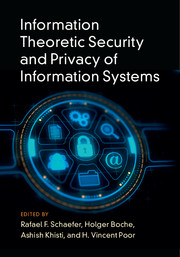Book contents
- Frontmatter
- Contents
- List of Contributors
- Preface
- Part I Theoretical Foundations
- Part II Secure Communication
- Part III Secret Key Generation and Authentication
- 12 Multiple Secret Key Generation: Information Theoretic Models and Key Capacity Regions
- 13 Secret Key Generation for Physical Unclonable Functions
- 14 Wireless Physical-Layer Authentication for the Internet of Things
- Part IV Data Systems and Related Applications
- Index
- References
14 - Wireless Physical-Layer Authentication for the Internet of Things
from Part III - Secret Key Generation and Authentication
Published online by Cambridge University Press: 28 June 2017
- Frontmatter
- Contents
- List of Contributors
- Preface
- Part I Theoretical Foundations
- Part II Secure Communication
- Part III Secret Key Generation and Authentication
- 12 Multiple Secret Key Generation: Information Theoretic Models and Key Capacity Regions
- 13 Secret Key Generation for Physical Unclonable Functions
- 14 Wireless Physical-Layer Authentication for the Internet of Things
- Part IV Data Systems and Related Applications
- Index
- References
Summary
Authentication of messages in an Internet of Things (IoT) is a key security feature that may involve heavy signaling and protocol procedures, not suitable for small devices with very limited computational capabilities and energy availability. In this chapter we address the problem of message authentication in an IoT context, by using physical-layer approaches. We propose a solution based on the use of trusted anchor nodes that estimate the channel from the transmitting node and report them to a concentrator node, which takes a decision on the message authenticity. Assuming that the anchor nodes have a limited energy availability, we analyze the lifespan of the authenticating network and propose both centralized and distributed approaches to determine which anchor nodes report the information to the concentrator. The authenticating network overhead is also discussed and a tradeoff between energy efficiency and signaling traffic is found.
IoT Authentication Overview
In the near future it is expected that many devices in common use will be connected to the Internet, thus enabling enhanced features and applications, from flexible home automation to customization of body area networks. Huge security challenges must be faced in this new scenario.We will focus on the authentication problem, i.e., the problem of determining whether a message has been truly transmitted by a specific device. In other words, we want to make sure that no malicious node is transmitting messages in place of a legitimate node.
In an IoT scenario the dramatically large number of nodes calls for simple authentication techniques. As will be discussed in more detail in Section 14.2, the most popular IoT standards address the problem of authentication only with approaches based on cryptography that require complex processing procedures and the exchange (and refresh) of keys among the devices. An open-minded approach, trying to include new techniques, e.g., at the physical layer, could contribute strongly to the solution of the problem.
Therefore, here we investigate solutions that exploit the features of wireless transmissions and can integrate well other authentication procedures implemented in the higher layers.
- Type
- Chapter
- Information
- Publisher: Cambridge University PressPrint publication year: 2017
References
- 2
- Cited by



